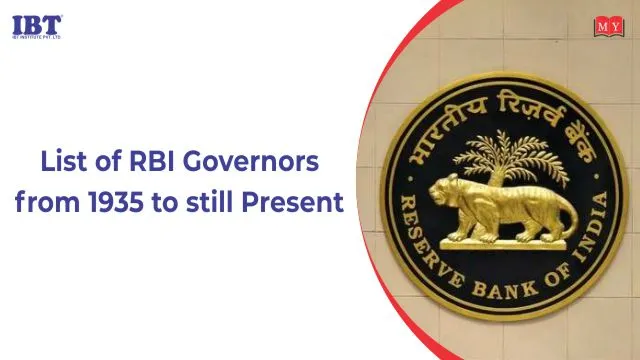
List of RBI Governors From 1935 to Still Present
Reserve Bank of India's Governor:
Reserve Bank of India governor is the chief executive of India’s central bank and the ex-officio chairperson of its Central Board of Directors. RBI acts as a parent body for all other commercial banks in India. In India, Rupee currency notes which are issued by the Reserve Bank of India (RBI), bear the governor’s signature. The First Governor of RBI was the British banker Osborne Smith in 1935, while the First Indian governor of RBI was C. D. Deshmukh.
RBI consists of the following members:
- One- Governor
- Four- Deputy Governor
- Fourteen- Directors
- Two- Government Officers
Powers of RBI Governor
The RBI Governor carries many powers. We can understand them with the help of the following points:
- Banker’s banker
- Head of all the commercial banks
- Influence on micro and macro economies
- Control over stock market
- Signature on currency notes
- Control over monetary, currency and credit system
Functions of RBI:
The core functions of Reserve Bank of India are
- Issue Bank Notes
- Banker to Government
- Custodian of Cash Reserves of Commercial Banks
- Custodian of Country’s Foreign Currency Reserves
- Lender of Last Resort
- Monetary Policy
- Central Clearance and Accounts Settlement
- Controller of Credit
- Buying and selling of Government securities (gilt edge, treasury bills, etc) and trade bills.
Governor's Eligibility:
Initially, RBI Governors were a part of Indian Civil services like C D Deshmukh, Bengal Rama Rao etc. but any individual who holds a Graduate degree/ Post Graduate/ Chartered Accountant can become a Governor of RBI provided that he/she had worked in any of the following institutions:
- IMF/ World Bank.
- Chairman or General Manager of a Bank.
- Reputed Financial or Banking organization.
- Ministry of Finance (GOI)
Other than the above any citizen who is 35 years or above than that is eligible. He must not be a member of the Parliament/State Legislature also he must not hold any other office for profit.
Appointment of RBI Governor:
The central government will elect the RBI governor. On the recommendation of the Finance minister, the PM of India will appoint the RBI governor.
Tenure of RBI Governor:
The tenure of an RBI Governors as specified in the constitution is three years however it can be extended for two more years. The Governor can be terminated in two cases and they are as follows:
- If dismissed by the President.
- Resignation is submitted by the Governor to the President.
Responsibilities of RBI Governor
Here are some duties which are generally performed by the RBI Governors.
- The RBI governors are responsible for maintaining the monetary stability in an economy. Thus, plays an important role in formulating the policies of the Reserve Bank of India.
- The responsibility for issuing licenses to open new foreign and private banks is also headed by the governor of RBI.
- The power to control the interest rates on advances and deposits of the country is vested upon the governors. However, the scope of this power is limited to prescribing minimum lending rates and interest rates on savings accounts.
- The financial system of the nation is regulated and administered by the Governor and he only sets the parameters within which the whole financial system functions.
- The Governor of RBI manages the external trade and payment also promotes orderly development and maintenance of foreign exchange market in India which comes under the foreign exchange management act, 1999.
- Monitoring of adequate quantities of currency notes and coins supply in the country and the issuance and destruction of currency not fit for circulation in public.
- RBI Governor also keeps a check on rules and regulations in order to make them more customer-friendly.
- Through Urban Bank Departments RBI governor leads and supervise primary co-operative banks.
- Furthermore, RBI Governor also has a part to play in facilitating and monitoring the flow of credit to small scale industries, rural, and agricultural sectors. The responsibility for regulating state co-operative banks, regional rural banks, and various local area banks.
List of RBI Governors
| S.No | Governors | Tenure |
| 1 | Osborne Smith | April 1, 1935, to June 30, 1937 |
| 2 | James Braid Taylor | July 1, 1937, to February 17, 1943 |
| 3 | C. D. Deshmukh | August 11, 1943, to June 30, 1949 |
| 4 | Benegal Rama Rau | July 1, 1949, to 14 January 1957 |
| 5 | K. G. Ambegaonkar | January 14, 1957, to 28 February 1957 |
| 6 | H. V. R. Iyengar | March 1, 1957, to February 28, 1962 |
| 7 | P. C. Bhattacharya | March 1, 1962, to June 30, 1967 |
| 8 | L. K. Jha | July 1, 1967, to May 3, 1970 |
| 9 | B. N. Adarakar | May 4, 1970, to June 15, 1970 |
| 10 | Sarukkai Jagannathan | June 16, 1970, to May 19, 1975 |
| 11 | N. C. Sen Gupta | May 19, 1975, to 19th August 1975 |
| 12 | K. R. Puri | August 20, 1975, to May 2, 1977 |
| 13 | M. Narasimhan | May 3, 1977, to November 30, 1977 |
| 14 | I.G. Patel | December 1, 1977, to 15 September 1982 |
| 15 | Manmohan Singh | September 16, 1982, to 14 January 1985 |
| 16 | Amitav Ghosh | January 15, 1985, to 4th February 1985 |
| 17 | R. N. Malhotra | February 4, 1985, to December 22, 1990 |
| 18 | S. Venkitaraman | December 22, 1990, to December 21, 1992 |
| 19 | C. Rangarajan | December 22, 1992, to November 21, 1997 |
| 20 | Bimal Jalan | November 22, 1997 to September 6, 2003 |
| 21 | Y. V. Reddy | September 6, 2003, to September 5, 2008 |
| 22 | D. Subbarao | September 5, 2008, to September 4, 2013 |
| 23 | Raghuram Rajan | September 4, 2013, to September 4, 2016 |
| 24 | Urjit Patel | September 4, 2016, to 11 Dec.2018 |
| 25 | Shaktikanta Das | From 12 Dec.2018 to till now |
Some important Points:
1. Longest Tenure Governor of RBI – Benegal Rama Rao. (Total of 7 years, 197 day). He was the head of RBI from July 1, 1949, to January 14, 1957.
2. The shortest tenure – Amitabh Ghosh. He was head of RBI for 20 days from 15 January 1985 to 4 February 1985.
3. Manmohan Singh is the only Prime Minister who was the Governor of RBI (1982 – 1985).
5. KJ Udeshi was the First woman Deputy Governor of RBI.
6. RBI has launched a website named www.paisaboltahai.rbi.org.in. to raise awareness about fake notes in the market and the ways how they can prevent themselves.
7. Government of India(Ministry of Finance) is responsible for the minting of coins and printing of 1 rupee notes and not RBI.
 4.5/5
4.5/5








